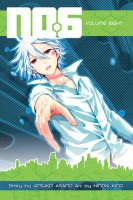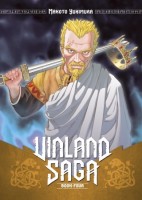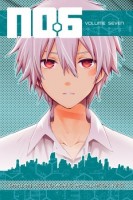 Creator: Hinoki Kino
Creator: Hinoki Kino
Original story: Atsuko Asano
U.S. publisher: Kodansha
ISBN: 9781612627946
Released: October 2014
Original release: 2014
Released both in Japan and in English in 2014, No. 6, Volume 9 is the final volume of Hinoki Kino’s manga series No. 6, an adaptation of a series of science fiction novels written by Atsuko Asano. The manga adaptation felt a little hurried at first, but the series’ pacing, characterization, and world-building continued to improve with each new volume. I have very much been enjoying the No. 6 manga. My introduction to No. 6 was actually through the eleven-episode anime series from 2011, directed by Kenji Nagasaki. I largely enjoyed the anime, but was disappointed with its extraordinarily rushed ending. One of the reasons why I was particularly happy when Kodansha Comics licensed the No. 6 manga for an English-language release was that I was hoping for a more satisfying conclusion to the story. Though there are some similarities between the two (including the same character designs), the manga and the anime adaptations are different interpretations of Asano’s original No. 6, each with their own merits. I was definitely curious to see how Kino would end the series.
Shion and Rat have failed in their mission to rescue Safu from the Correctional Facility, barely managing to flee with their own lives. To make matters worse, Rat has been critically injured—shot in the chest while trying to protect Shion during their escape. Shion was able to give Rat first aid, but the other young man is in desperate need of proper medical attention. However, the facilities that could save Rat’s life don’t exist within West Block. No. 6, the city that Rat wishes above all else to destroy, holds his only hope, and it is now in chaos. The citizenship is dangerously close to revolt and fear is sweeping across the populace. Some of the turmoil was cause by Shion and Rat during their attack on the Correctional Facility, but there are also others within No. 6 itself who are seeking revenge against the state, fanning the flames of discontent. Rat and Shion have so far been able to survive, but their fight is far from over. Shion doesn’t even have time to grieve for Safu if he wants to prevent losing more of the people he loves dearly.
Because I started reading the No. 6 manga in part because I had seen the anime, at times it’s difficult for me not to compare the two. And as previously mentioned, I was particularly interested in how Kino would end the series. I’m not certain how it compares to Asano’s original novels, but the manga’s conclusion is much more comprehensive than the anime’s. (Actually, I can make some more sense out of the anime now that I have read the manga.) The last few volumes have been increasingly intense. The sudden relaxation of all of that tension in No. 6, Volume 9 is very disconcerting, and even a little anticlimactic, as the immediate danger passes. However, the Correctional Facility has been destroyed and the wall between No. 6 and West Block has begun to fall. There may be a temporary lull in which people momentarily feel safe, but peace will be a long time in coming as resentment and hatred still exist and pose a threat. Taking this into consideration, Kino’s ending allows for that and, while the ending is complete, there is a sense that the world of No. 6 and the struggle continues beyond the page.
Although No. 6, Volume 9, mostly provides a satisfying conclusion to the manga series, at times it does feel like it’s only really scratching the surface of a much more complicated and detailed story. However, all of the major plot threads are addressed and resolved, including the revelation of the meaning behind the parasitic bees and the explanation of the secret experiments being carried out in No. 6. Granted, it does take an infodump or two to fit it all into the last volume, but they work and their inclusion actually makes a fair amount of sense within the context of the narrative. Where Kino’s No. 6 really excels though is with the evolution and development of Rat and Shion. They begin the series with straightforward personalities that become increasingly layered and complex as the manga progresses. Shion is benevolent but also frightening; Rat’s apparent strength hides his frailty. Their roles in their relationship with each other have reversed several times throughout the series and continue to shift and change all the way to its end. I came to care about Shion and Rat immensely and am very glad to finally have a much more thorough ending to their story.




